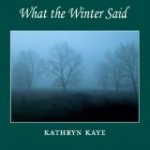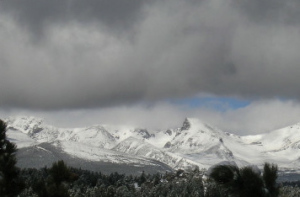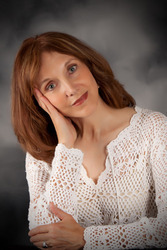 With the Fall colors starting to fade outside my window, and a chilly wind stripping the leaves from the trees, sending them flying in every direction, I’m in a proper frame of mind to write about pianist Kathryn Kaye’s brand new album, What the Winter Said. And its not unlikely that scenes such as this inspired the music in the first place. In her words: “Although the inspiration for my compositions comes from a variety of sources, the strongest by far is nature. I’m moved by nature’s colors, sounds, and changing seasons, all of which blend with melodies and visual images from my past.” Given the diversity of places Kathryn has lived and the vistas she has seen, her visual memories must be rich, indeed. Growing up in the Appalachian Mountains of southeast Kentucky and living there through her college years, she eventually moved to Germany to continue her musical training. These days, Kathryn composes her pastoral melodies surrounded by the bucolic splendor of Colorado’s Rocky Mountains where she resides. But it is not just these sights that have shaped her creative direction, but also the sounds. From the homespun harmonies of folk songs and hymns of Kathryn’s youth, to the influence of Satie, Liszt, and Brahms in later years, these influences form part of the musical DNA her own distinctive style has evolved from.
With the Fall colors starting to fade outside my window, and a chilly wind stripping the leaves from the trees, sending them flying in every direction, I’m in a proper frame of mind to write about pianist Kathryn Kaye’s brand new album, What the Winter Said. And its not unlikely that scenes such as this inspired the music in the first place. In her words: “Although the inspiration for my compositions comes from a variety of sources, the strongest by far is nature. I’m moved by nature’s colors, sounds, and changing seasons, all of which blend with melodies and visual images from my past.” Given the diversity of places Kathryn has lived and the vistas she has seen, her visual memories must be rich, indeed. Growing up in the Appalachian Mountains of southeast Kentucky and living there through her college years, she eventually moved to Germany to continue her musical training. These days, Kathryn composes her pastoral melodies surrounded by the bucolic splendor of Colorado’s Rocky Mountains where she resides. But it is not just these sights that have shaped her creative direction, but also the sounds. From the homespun harmonies of folk songs and hymns of Kathryn’s youth, to the influence of Satie, Liszt, and Brahms in later years, these influences form part of the musical DNA her own distinctive style has evolved from.
And it’s a style that I have enjoyed in the past when I wrote about her previous albums, Dreaming Stilland Heavy as a Feather, which I described as “evoking the earthy ambience and subtle shadings of an Andrew Wyeth painting.” While her new album bears many of the stylistic similarities of her earlier works, it differs in that is thematically based as a seasonal/ holiday album. This collection includes ten original compositions, as well as four older (16th to 18th century), less familiar but very pretty carols. I appreciate the fact that Kathryn has chosen not to go with the well-trodden classic holiday songs but breathes new life into less well-known tunes from the past. Another “cover” tune on the album is a sweet version of Will Ackerman’s “The Bricklayer’s Beautiful Daughter.” The inclusion of this lovely tune is no surprise, considering that Mr. Ackerman, the Grammy winning producer and founder of Windham Hill Records, co-produced Kathryn’s album at his picturesque Imaginary Roads Studio in Vermont. One of the many benefits of recording there is the opportunity to use the studio’s highly customized Steinway B piano and the extensive collection of microphones for capturing it’s world class sound. Like many of Will’s productions, this one also includes the talents of a number of his A-list studio musicians who accompany Kathryn on her wintery journey.
The first track, entitled “A Rose In Winter,” however, is a solo piano performance by Kathryn that sets the tone  for the album with its gentle understated melody that captures the bloom of beauty set against the tranquil backdrop of the season. In her words: “The winter season is a time for celebration, as well as quiet contemplation and reflection.” And this sentiment perfectly portrays the essence of this piece, as well as the album in general. The next song, “Brightest and Best,” is one of the traditional tunes Kathryn covers, and dates back to 1835. She is accompanied on this bittersweet melody by a duo of my favorite Imaginary Roads recording regulars – violinist Charlie Bisharat, who is known for his work with Yanni, and percussionist Jeff Haynes who has played with the Pat Metheney Group. I also enjoyed being introduced to classical musician Gus Sebring of the Boston Symphony Orchestra accompanying on French horn. On the dreamy “Midwinter Lullaby,” one of Kathryn’s original songs, the piece builds from solo piano for the first movement, to be joined by Grammy winning cellist Eugene Friesen of the Paul Winter Consort. The third member of this talented trio was Jill Haley on English horn, whose own excellent music I’ve had the pleasure of writing about. The more up-tempo, yet serene song “The Shortest Days,” features the maestro Ackerman himself on guitar, along with a number of other accompanists. While not a Christmas carol, per se, there is something of a holiday or seasonal air that this piece exudes. On “Sky Full of Stars,” Kathryn’s left hand ostinato provided a twinkling quality that fit the theme of the song perfectly and created an animated atmosphere for her and the other musicians to glide over.
for the album with its gentle understated melody that captures the bloom of beauty set against the tranquil backdrop of the season. In her words: “The winter season is a time for celebration, as well as quiet contemplation and reflection.” And this sentiment perfectly portrays the essence of this piece, as well as the album in general. The next song, “Brightest and Best,” is one of the traditional tunes Kathryn covers, and dates back to 1835. She is accompanied on this bittersweet melody by a duo of my favorite Imaginary Roads recording regulars – violinist Charlie Bisharat, who is known for his work with Yanni, and percussionist Jeff Haynes who has played with the Pat Metheney Group. I also enjoyed being introduced to classical musician Gus Sebring of the Boston Symphony Orchestra accompanying on French horn. On the dreamy “Midwinter Lullaby,” one of Kathryn’s original songs, the piece builds from solo piano for the first movement, to be joined by Grammy winning cellist Eugene Friesen of the Paul Winter Consort. The third member of this talented trio was Jill Haley on English horn, whose own excellent music I’ve had the pleasure of writing about. The more up-tempo, yet serene song “The Shortest Days,” features the maestro Ackerman himself on guitar, along with a number of other accompanists. While not a Christmas carol, per se, there is something of a holiday or seasonal air that this piece exudes. On “Sky Full of Stars,” Kathryn’s left hand ostinato provided a twinkling quality that fit the theme of the song perfectly and created an animated atmosphere for her and the other musicians to glide over.
Another of the songs that Kathryn pays tribute to is the traditional Catalonian tune, “Carol of the Birds,” which has been covered by many artists from Joan Baez to Manheim Steamroller. This quietly respectful instrumental version includes a soulful duet with Eugene Friesen on cello in the second half. The other two traditional carols were one’s I wasn’t familiar with, and were entitled “Huron Carol” and “The Holly Bears a Berry,” which also features Will Ackerman on guitar. While many of the songs on the album are graced by some of the finest musicians in this genre, their contributions are subtly and tastefully integrated, allowing the spotlight to shine on Kathryn’s exquisite compositions and elegant piano performance. The title track is another piano solo that has a serene semi-classical feel with a melody that evoked an image of snowflakes falling gently to earth – quite perfect. The album concludes, paying homage to Kathryn’s Appalachian roots on a tune called “Cumberland Mountain Hymn.” There is a down to earth simplicity on this piece that is augmented by the accordion and autoharp accompaniment of Tom Eaton, who also engineered and helped produce the recording, as he does on many of the projects at the studio.
 I’ve always been impressed with Kathryn’s abilities as a composer and it was interesting to hear her speak about her creative process, which she describes in this way: “I never have a goal when I write songs. Instead, I stay out of the way and allow the music to happen. It is my hope that what I write will resonate with someone else, but in that person’s uniquely personal way, even if it’s very different from my own experience as I compose and play. Most of the music I write takes me by surprise, sometimes feeling like an accident! I’ve come to believe that nature, the world, and even the universe are full of creative accidents that are cause for celebration.” Whether the haunting refrains on this album came about by “accident” or design, Kathryn has managed to produce another beautifully crafted album that compares favorably with her two previous chart-topping releases. While the warmth of the sweet melodies on this album is perfect for taking the chill off a cold winter’s day, the fact that the carols she has chosen to interpret are not as well known or immediately associated with the holidays, makes this recording one that can be enjoyed year round. What the Winter Said is a welcome addition to Kathryn Kaye’s growing musical garden.
I’ve always been impressed with Kathryn’s abilities as a composer and it was interesting to hear her speak about her creative process, which she describes in this way: “I never have a goal when I write songs. Instead, I stay out of the way and allow the music to happen. It is my hope that what I write will resonate with someone else, but in that person’s uniquely personal way, even if it’s very different from my own experience as I compose and play. Most of the music I write takes me by surprise, sometimes feeling like an accident! I’ve come to believe that nature, the world, and even the universe are full of creative accidents that are cause for celebration.” Whether the haunting refrains on this album came about by “accident” or design, Kathryn has managed to produce another beautifully crafted album that compares favorably with her two previous chart-topping releases. While the warmth of the sweet melodies on this album is perfect for taking the chill off a cold winter’s day, the fact that the carols she has chosen to interpret are not as well known or immediately associated with the holidays, makes this recording one that can be enjoyed year round. What the Winter Said is a welcome addition to Kathryn Kaye’s growing musical garden.

